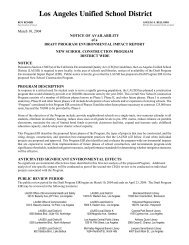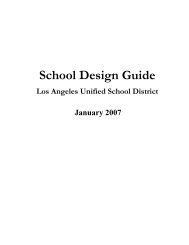Site-Specific Health and Safety Plan (HASP) - Laschools.org
Site-Specific Health and Safety Plan (HASP) - Laschools.org
Site-Specific Health and Safety Plan (HASP) - Laschools.org
Create successful ePaper yourself
Turn your PDF publications into a flip-book with our unique Google optimized e-Paper software.
LAUSD Proposed South Region High School #9 & Middle School #4<br />
13-1<br />
December 2006<br />
<strong>Site</strong> <strong>Specific</strong> <strong>Health</strong> & <strong>Safety</strong> <strong>Plan</strong> (<strong>HASP</strong>)<br />
13.0 DECONTAMINATION PROCEDURES<br />
An exclusion zone, contamination reduction zone, <strong>and</strong> support zone will be established, as<br />
needed, when field personnel are using PPE. Decontamination station layout will be made on a<br />
site-specific basis <strong>and</strong> will be based on the level of PPE used, the types of chemical hazards<br />
encountered, <strong>and</strong> the site conditions, including topography, wind direction, <strong>and</strong> traffic patterns.<br />
Defined site access <strong>and</strong> egress points will be established <strong>and</strong> personnel will enter <strong>and</strong> exit only<br />
through these points. Generally, persons assisting in the decontamination station may be in one<br />
level lower of respiratory protection than required in the work zone.<br />
If personnel are in Level D-modified protection (no respirator but using protective gloves <strong>and</strong>/or<br />
suits <strong>and</strong> other equipment), a portable decontamination station will be set up at the site. The<br />
decontamination station will include provisions for collecting disposable PPE (e.g., garbage<br />
bags); washing boots, gloves, vinyl rain suits, field instruments <strong>and</strong> tools; <strong>and</strong> washing h<strong>and</strong>s,<br />
face, <strong>and</strong> other exposed body parts. Used PPE <strong>and</strong> disposable equipment will be double-bagged<br />
<strong>and</strong> placed in a municipal refuse dumpster on site. These wastes are not considered hazardous<br />
<strong>and</strong> may be sent to a municipal l<strong>and</strong>fill. Any PPE <strong>and</strong> disposable equipment that is to be<br />
disposed of that is still reusable will be rendered inoperable before disposal in the refuse<br />
dumpster.<br />
Decontamination equipment may include:<br />
• Plastic buckets <strong>and</strong> pails;<br />
• Scrub brushes <strong>and</strong> long-h<strong>and</strong>le brushes;<br />
• Detergent;<br />
• Containers of water;<br />
• Paper towels;<br />
• Plastic garbage bags;<br />
• Plastic or steel 55-gallon barrels; <strong>and</strong><br />
• Distilled water.<br />
If personnel are in Level C protection (respirator <strong>and</strong> using protective gloves <strong>and</strong>/or suits <strong>and</strong><br />
other equipment), a portable decontamination station will be set up at the site as described above<br />
for Level D-modified protection. In addition, personnel should inspect, clean <strong>and</strong> disinfect,<br />
repair, <strong>and</strong> properly store all respirators.<br />
Respirators should be inspected before <strong>and</strong> after each use. Respirators reserved for emergency<br />
use should be inspected on a monthly basis to ensure that they will perform satisfactorily.<br />
Thoroughly check all connections on respirators to ensure that gaskets <strong>and</strong> “O” rings are in<br />
place. Check for proper tightness. Check the condition of the facepiece assembly, the<br />
connecting air tube <strong>and</strong> headb<strong>and</strong>s. Inspect rubber or elastomer parts for pliability <strong>and</strong> signs of<br />
deterioration. Maintain a record for each respirator inspection. Each inspection record should<br />
include inspection date, inspector’s name, <strong>and</strong> any unusual conditions or findings.<br />
Only a trained person with proper tools <strong>and</strong> replacement parts should work on respirators. No<br />
one should ever attempt to replace components or to make adjustments or repairs beyond the<br />
manufacturer’s recommendations.<br />
Follow manufacturers’ storage instructions that are always furnished with new respirators or<br />
affixed to the lid of the carrying case. In addition, these general instructions may be helpful:<br />
241







